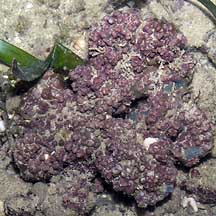 |
|
|
Coralline
red algae
Family
Corallinaceae
updated
Aug 08
Where
seen?
Forming pinkish encrusting growths on coral rubble, coralline algae
are commonly seen, especially on our Southern shores.
Features: These red seaweeds are
hard because they incorporate calcium carbonate. Being hard, they
are sometimes also called coralline algae. Some kinds of coralline
algae cover hard surfaces in a thin, slow- growing layer. They grow
on things like stones, coral rubble, litter such as discarded bottles
and washed up pieces of wood. They may even coat the shells of living
snails. Other kinds of coralline algae may form upright structures
such as leafy or branched forms.
Role in the habitat: Many coralline
algae produce chemicals that promote the settlement of larvae of sea
creatures. These sea creatures may help the coralline algae by grazing
at competing, faster growing algae. Some of these sea creatures are
commercially important, e.g., abalones. By cementing small things
together, encrusting red seaweeds help to maintain and build up the
reef. The algae also provide hiding places for tiny creatures and
larvae.
|
|
Coralline
algae recorded for Singapore
from Wee Y.C. and Peter K. L. Ng. 1994. A First Look at Biodiversity
in Singapore.
| |
Coralline
red algae awaiting identification
*Seaweed species are difficult to positively identify without
microscopic examination. On this website, they are grouped by
external features for convenience of display. |
| |
Amphiroa
fragilissima
Amphiroa rigida |
|
Links
References
- Wee Y.C.
and Peter K. L. Ng. 1994. A First Look at Biodiversity in Singapore.
National Council on the Environment. 163pp.
- Chou, L.
M., 1998. A
Guide to the Coral Reef Life of Singapore. Singapore Science
Centre. 128 pages.
- Calumpong,
H. P. & Menez, E. G., 1997.Field
Guide to the Common Mangroves, Seagrasses and Algae of the Philippines
 .
Bookmark, Inc., the Philippines. 197 pp. .
Bookmark, Inc., the Philippines. 197 pp.
- Huisman,
John M. 2000. Marine
Plants of Australia
 University of Western Australia Press. 300pp.
University of Western Australia Press. 300pp.
- Trono, Gavino.
C. Jr., 1997. Field
Guide and Atlas of the Seaweed Resources of the Philippines.
 .
Bookmark, Inc., the Philippines. 306 pp. .
Bookmark, Inc., the Philippines. 306 pp.
|
|
|


